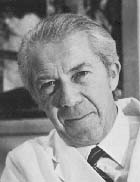Christian de Duve was awarded the Dr H.P. Heineken Prize for Biochemistry and Biophysics 1973 for his discovery of the cell organelles called the lysosome and peroxisome.
As with many scientific discoveries, chance and the unpredictable played a significant part. While studying the mechanism of action of insulin as part of research into diabetes and carbohydrate metabolism, the expected activity of the acid under study (phosphatase) deviated significantly from expectations. Realizing this was something new, de Duve shifted the emphasis of research to this new ‘mechanism of the latency phenomenon’. De Duve postulated that the enzyme was surrounded by a membrane which prevented it from affecting the other cell components.
In 1955, De Duve introduced the term lysosome to describe what was then still a hypothetical particle as yet unobserved with the microscope. Later the same year, the American scientist Alex Novikoff succeeded in demonstrating the lysosome with the electron microscope. During further study, it became clear that the lysosomes were not only the storage sites of acid phosphatase, but also of various types of enzymes all belonging to the group of lytic enzymes or those concerned with decomposition. Further study showed that the variety of enzymes in the lysosome was so great that nearly all macromolecules involved in cell composition could be decomposed by the lysosomal enzymes.
It is now clear that lysosomes are the main components of an intracellular digestive system that has been recognized in a wide variety of cells, both in plants and animals. The discovery of the lysosome and of its effect and function has also had important consequences for medicine. In diseases such as rheumatism, cancer, arthritis, infections, poisoning and in some hereditary disorders the role of the lysosome is now the focus of scientific attention. De Duve has not only discovered the lysosome but also the peroxisome, another cell particle in which a number of enzymes can be localized, although the activity of these is not latent as it is in the lysosomal enzymes.
About the laureate
Christian de Duve, who is of Belgian nationality, was born at Thames-Ditton (UK) on October 2, 1917. He studied medicine at the University of Louvain (Doctor of Medicine in 1941), after which he specialized in chemistry at the Nobel Institute, Stockholm and in biochemistry at the Department of Biological Chemistry, Washington University Medical School, St. Louis (USA). From 1947 to 1951 he was lecturer in physiological chemistry at the Catholic University of Louvain, later being appointed professor at the same university and head of the Department of Physiological Chemistry. In 1962 he was appointed Professor and Head of the Department of Biochemical Cytology at the Rockefeller University, New York (USA).
De Duve started his scientific career researching into diabetes and carbohydrate metabolism. Further studies led him to the discovery of the lysosome.
De Duve has published a great number of articles, and has sat on the editorial boards of the Journal of Theoretical Biology and the Journal of Cell Biology among other journals. He is still one of the editors of Subcellular Biochemistry and of Preparative Biochemistry. De Duve is an honorary member of various societies (e.g. the American Academy of Arts and Sciences), has received honorary degrees from the Universities of Turin, Leyden and Sherbrooke (Canada), and has received several awards including the Nobel prize for medicine in 1974 with Albert Claude of Belgium and George Emil Palade of the United States of America.
De Duve passed away in May 2013.
